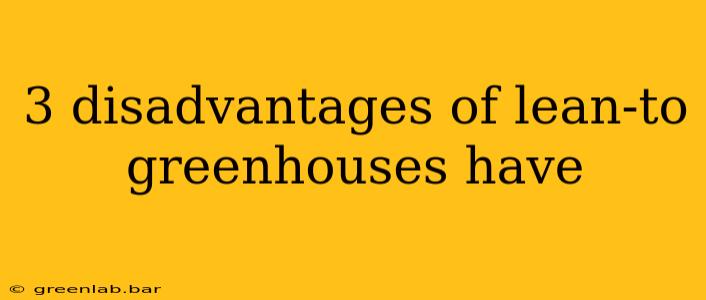Lean-to greenhouses offer a space-saving and often budget-friendly solution for home gardeners. However, like any structure, they come with certain drawbacks. Before you decide if a lean-to is right for your needs, it's crucial to understand these limitations. This article will explore three significant disadvantages of lean-to greenhouses, helping you make an informed decision.
1. Limited Growing Space and Light Exposure: A Small Footprint with Big Implications
One of the most prominent downsides of a lean-to greenhouse is its inherent limitation in size and light penetration. Because they're attached to an existing structure (like a house or barn), lean-tos are typically narrower and shorter than freestanding greenhouses. This directly translates to less growing area. You might struggle to comfortably accommodate larger plants or a diverse range of crops.
Furthermore, the angle of the lean-to roof often restricts the amount of direct sunlight reaching your plants. While morning or afternoon sun might be ample, the midday sun, crucial for photosynthesis, can be significantly reduced depending on the lean-to's orientation and the height of the attached structure. This reduced sunlight can impact plant growth and yield, especially for light-demanding species. Consider the sun's path throughout the year when choosing your lean-to's location and angle.
2. Potential for Temperature Fluctuations and Heat Loss: A Balancing Act Between Warmth and Ventilation
Lean-to greenhouses are often more susceptible to temperature fluctuations than freestanding models. The close proximity to an existing building can affect the microclimate within the greenhouse. Heat absorbed by the building during the day might not be readily released at night, leading to slower temperature drops within the greenhouse. Conversely, the attached structure can also lead to faster heat loss during colder periods.
Effective ventilation is crucial to mitigate these temperature swings, yet lean-to designs may present challenges in this area. Limited wall space might restrict the number and size of vents you can install, hindering your ability to regulate the internal temperature effectively. Proper planning and consideration of ventilation options are essential to avoid overheating during summer months or freezing temperatures during winter.
3. Structural Limitations and Potential for Damage: A Need for Careful Planning and Construction
The design of a lean-to greenhouse inherently means it's attached to an existing structure. This integration can lead to structural limitations and potential damage if not carefully planned and built. For example, the weight of the greenhouse, particularly when loaded with water or snow, needs to be considered in relation to the structural integrity of the attached building. Poorly designed or constructed lean-tos might put undue stress on the building’s foundation or walls.
Furthermore, the materials used for construction need to be compatible with the existing structure. Mismatched materials or improper installation can lead to issues like water damage or structural weakness over time. Consult a building professional if you have any concerns about the structural integrity of your chosen location or design before starting construction. This precaution can save you significant time, money, and frustration in the long run.
Conclusion:
While lean-to greenhouses offer advantages in terms of cost and space-saving designs, it's crucial to carefully weigh these three key disadvantages. By understanding the limitations regarding growing space, temperature regulation, and structural considerations, you can make a more informed decision about whether a lean-to greenhouse is the right choice for your gardening needs. Thorough planning and careful construction are vital to mitigate these drawbacks and maximize the benefits of your lean-to greenhouse.

